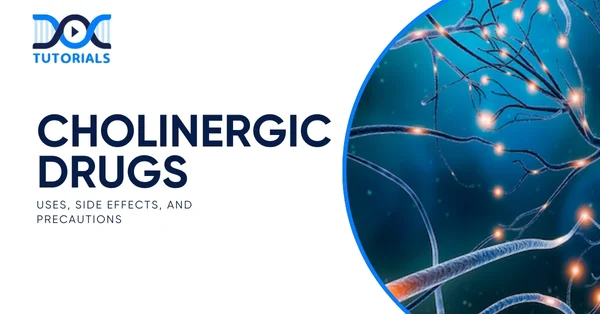Cholinergic Drugs: Uses, Side Effects, and Precautions

Cholinergic drugs are the kind of drugs that interfere with acetylcholine, which is the most important neurotransmitter of the parasympathetic nervous system. The agents are important in promoting or stimulating the parasympathetic activity.
Their application is common in the treatment of a wide variety of conditions such as myasthenia gravis, Alzheimer’s disease and other dementia conditions. It is very important to know the pharmacology, classification, clinical uses, side effects, and precautions of employing cholinergic medications in order to treat patients safely and effectively.
If you are a medical student getting ready for the NEET PG exam, it is important to fully understand how cholinergic agents work, when they should be used, when they shouldn’t be used, and what side effects they might have. Keep reading for a detailed insight.
What are Cholinergic Drugs?
Cholinergic drugs belong to a group of medications that stimulate muscarinic receptors within the parasympathetic nervous system. These receptors regulate various involuntary functions such as digestion, salivation, and heart rate.
When cholinergic drugs are administered, they enhance these automatic responses, leading to increased salivation, frequent urination, and greater mucus secretion.
What is the Classification of Cholinergic Drugs?
The cholinergic drugs classification is broadly divided into 2 main categories: direct-acting and indirect-acting agents. All types of cholinergic drugs are classified under these 2 headings:
- Direct-Acting Cholinergic Drugs
These medications exert their effects by directly stimulating cholinergic receptors – either muscarinic or nicotinic. This group aligns closely with the definition of cholinergic activity. Direct-acting agents are further subdivided into choline esters and plant alkaloids.
Choline esters include drugs such as acetylcholine, carbachol, bethanechol, and methacholine. Plant-derived alkaloids in this category include pilocarpine, muscarine, and nicotine.
- Indirect-Acting Cholinergic Drugs
These drugs act by either inhibiting the enzyme cholinesterase (which breaks down acetylcholine) or by enhancing the release of acetylcholine. This group includes both reversible and irreversible cholinesterase inhibitors.
In addition, certain anti-adrenergic medications that suppress sympathetic activity also fall under this classification. Some examples of indirect-acting cholinomimetic drugs are donepezil, malathion, paliperidone and propranolol.
What are the Uses of Cholinergic Drugs?
Some of the clinical circumstances in which cholinergic medications are used are:
- Myasthenia Gravis
Medications like pyridostigmine are commonly given as first-line treatment. Neostigmine is another option, though it is used less frequently.
- Dementia and Alzheimer’s Disease
Donepezil, rivastigmine, and galantamine are prescribed to enhance cognition and overall functioning in patients with mild to moderate Alzheimer’s disease. These drugs are also used off-label for Parkinson’s and Lewy body dementia.
- Glaucoma and Eye Surgeries
In ophthalmology, pilocarpine and carbachol help reduce intraocular pressure in patients with open-angle glaucoma. Carbachol is also used during cataract and other intraocular surgeries. Pilocarpine can be used as eye drops to clear the effects of eye-dilating agents, or it might be used to treat a certain eye disorder.
- Reversal of Muscle Relaxants Post-Surgery
In tertiary care centres, neostigmine is used after surgery to reverse muscle paralysis caused by anaesthetic agents. It is typically combined with atropine to block unwanted side effects.
- Postoperative Urinary Retention
Bethanechol and neostigmine are used in post-surgical wards to manage urinary retention that is not due to any physical obstruction.
- Neurogenic Bladder
Patients with spinal cord injuries or other neurological conditions may be treated with bethanechol to improve bladder emptying.
- Acute Colonic Pseudo-Obstruction
Though less commonly used in rural setups, neostigmine may be employed off-label in emergency departments of urban hospitals for this intestinal condition.
- Dry Mouth (Xerostomia)
For patients experiencing dry mouth due to Sjögren’s syndrome or radiation therapy for head and neck cancers, cevimeline or pilocarpine may be prescribed when other options like artificial saliva are ineffective. These drugs are particularly useful in oncology centres and ENT (ear, nose, and throat) departments.
- Anticholinergic Poisoning
Physostigmine is used as an antidote in critical care units for cases of poisoning caused by belladonna alkaloids, diphenhydramine, or similar substances. Such cases are often seen in emergency departments following accidental or intentional overdose.
- Snakebite
In regions of India where venomous snakebites are common, neostigmine may serve as a supportive treatment in neurotoxic envenomation when antivenom is not accessible or fails to provide relief.
- Tensilon Test
Edrophonium, once used in the diagnosis of myasthenia gravis, is no longer available in many countries, but it holds historical relevance in medical training.
What are the Side Effects of Cholinergic Drugs?
Cholinergic drugs, while beneficial in many clinical settings, may also lead to a range of side effects due to their stimulation of the parasympathetic nervous system. Commonly observed adverse effects include:
- Excessive saliva production
- Increased sweating
- Feeling of nausea and episodes of vomiting
- Loose motions or diarrhoea
- Cramping or discomfort in the abdomen
- Frequent urge to urinate
- Sensation of light-headedness or dizziness
- Drop in blood pressure
- Narrowing of the airways
- Overproduction of bodily secretions
What are the Precautions of Cholinergic Drugs?
Cholinergic drugs must be prescribed with care, as they can aggravate certain pre-existing health conditions. These medications are contraindicated in individuals with any form of obstruction in the digestive or urinary tract. Conditions such as tumours or severe inflammation that cause blockages may worsen if cholinergic agents are administered.
Caution is also essential when treating patients with asthma, epilepsy, bradycardia (slow heart rate), hyperthyroidism, or gastric ulcers. Since cholinergic drugs mimic the actions of the parasympathetic nervous system, they can significantly reduce heart rate and increase bodily secretions such as saliva, gastric acid, and tears.
In patients with underlying heart rhythm disorders or gastrointestinal issues, such stimulation may worsen symptoms. For instance, increased stomach acid can intensify ulcers, and a slowed heart rate can further compromise cardiovascular stability. Therefore, these drugs should be used carefully in such cases, only under strict medical supervision.
FAQs About Cholinergic Drugs
- What are cholinergic drugs?
Cholinergic drugs are a group of medications that act on acetylcholine, the main neurotransmitter of the parasympathetic nervous system. These drugs either mimic or enhance parasympathetic activity in the body.
- How are cholinergic drugs classified?
Cholinergic drugs are broadly classified into 2 types:
- Direct-acting agents, which stimulate muscarinic or nicotinic receptors directly.
- Indirect-acting agents, which increase acetylcholine levels by inhibiting cholinesterase or enhancing acetylcholine release.
- Are cholinergic drugs safe for children?
Certain cholinergic drugs are considered appropriate for paediatric use. Bethanechol can also be used in children as a medicine to treat urinary conditions, whereas pilocarpine eye drops may be administered to people to treat certain eye ailments. Varenicline can be prescribed as a medication that helps adolescents aged 17 and older quit smoking.
- Can seniors take cholinergic drugs?
Yes, cholinergic drugs can be prescribed to elderly patients, especially when treating symptoms such as dementia, glaucoma, or urinary retention. However, it is essential not to overlook the consequences of age-related health issues like heart disease or low blood pressure, which put the patient at risk of experiencing side effects.
- What are some examples of direct-acting cholinergic drugs?
Some examples of direct-acting cholinergic drugs are as follows:
- Choline Esters: Acetylcholine, methacholine, carbachol, bethanechol
- Plant Alkaloids: Pilocarpine, muscarine, nicotine
Conclusion
A solid grasp of cholinergic drugs, including their mechanism of action, classification, therapeutic uses, precautions, and adverse effects, is crucial for both clinical practice and academic success. Such agents are a major drug type in the field of autonomic pharmacology, and they have broad application in various fields like neurology, ophthalmology, and urology.
As a NEET PG aspirant, understanding this topic will not only equip you with the concept of pharmacology but also help you become more comfortable approaching integrated clinical scenarios.
DocTutorials provides well-organised items such as high-yield video lectures, concise notes and expert-facilitated discussions to assist you in preparing for the exam.
Join DocTutorials today and explore our NEET PG course to excel in your medical career.
Latest Blogs
-

NEET PG Exam 2025- Date, Pattern, Marking Scheme, Subject Wise Weightage, and Exam Mode
NEET PG Exam 2025 is the ultimate gateway for medical graduates aspiring to pursue postgraduate courses in medicine, including MD,…
-

INI CET Exam 2025: Your Roadmap to Success – Key Topics, Strategies, and Lessons from Last Year’s Papers
The INI CET exam is more than just a test; it’s a significant milestone for many medical students aiming to…
-

INI CET Exam Success: Previous Year Question Papers & Ultimate Guide – INI CET PYQ
One can feel overwhelmed while preparing for the INI CET (Institute of National Importance Combined Entrance Test). A vast syllabus,…




